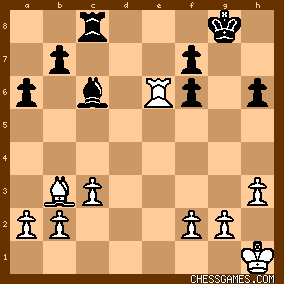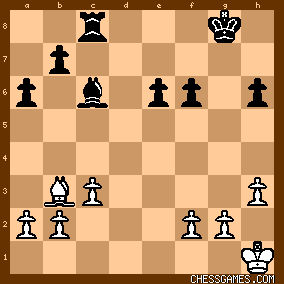| Jan-17-04 | | PinkPanther: I'm gonna refrain from saying anything except for "caro-kann > french defense". |
|
| Jan-17-04 | | technical draw: As my friends in Viet-nam would say.."French defence numba ten!" |
|
| Jan-17-04 | | WMD: This win was vintage Adams. Innocuous but deadly. Now if only he can play well against his bete noire, Anand. |
|
| Jan-17-04 | | technical draw: <WMD> Adams is looking very strong in this tournament. Do not be surprized if he finishes ahead of Kramink, Anand, et al. |
|
| Jan-17-04 | | WMD: Bareev is trying prove Fischer was right: the French Defence is anti-positional and weakens the kingside. Just look at the final position. I sense that Adams is happy with his place in the chess world and doesn't push for too much. You could say he lacked ambition but given his pragmatic approach to chess it's probably entirely realistic. |
|
| Jan-17-04 | | Benjamin Lau: Fischer may have been biased in his assessments however as he had scored (relatively) poorly against the French Winawer. What exactly does it mean for an opening to be "anti-positional?" |
|
| Jan-17-04 | | WMD: Yes, I think Fischer was only talking about the French Winawer. I confess to not like playing vs the French. I now play 2.b3 as Larsen tried a few times. That always causes those ICC automatons to pause a few seconds before they bang out d5 in reply. |
|
| Jan-18-04 | | pks147: come on people black blunderd by a tactical oversight, just becuase black made a blunder doesnt mean the french is a bad opening, it is the most feared by white. |
|
| Jan-18-04 | | PinkPanther: <come on people black blunderd by a tactical oversight, just becuase black made a blunder doesnt mean the french is a bad opening, it is the most feared by white.>
What kind of a statement is that? Back in the days when I used to play e4 with some regularity, I didn't fear the French Defense at all. |
|
| Jan-18-04 | | Benjamin Lau: The French works against some players, it doesn't against others. That's the point of having a repertoire, so you can switch when you're coming up against a "French slayer." |
|
| Mar-05-04 | | InspiredByMorphy: What made you switch to d4 PinkPanther? |
|
| May-16-04 | | PinkPanther: Oh. whoops..I'm a bit late answering this question. I still play e4 for anybody who's interested. In the beginning i played the Reti System/ King's Indian attack sort of set up (those were the days where I was a beginner and knew basically nothing about chess openings) and then progressed to e4 and then to d4. I went to d4 just for the sake of broadening by opening repertoire and found out that I actually liked the positions that arose much better (in general) than those you commonly see in e4 openings. Also, there are some e4 openings that I absolutely can't stand playing against, namely the Scandinavian Defense, and the Sicilian Dragon, so in a way I was sort of driven out of playing e4 (but I still do it for the heck of it and so I don't get bored with d4 openings). There are some openings I don't like playing against with d4, but they are not as numerous and I don't have as much "disgust" for them. Also, in general d4 openings are slower and more positionally oriented which suits my style better. I'm sure I've gone in depth with this somewhere else on the site, where I actually mention the systems I play against all the major d4 openings, but I can't remember where that was, and quite frankly, I'm pretty sure what I play now differs from what I played back then. |
|
| May-16-04 | | Hanada: <PinkPanther>
That's interesting that you started with Reti/KIA type openings as a beginner. As a rule, when I teach people, I always start them off with a classical approach to the game...pawns in the center, knights before bishops, castle early, etc... And I recommend that they use e4 exclusively in the beginning which tends to lead to a more tactical game, which I think will help beginner's more in the long run. Then, once the person has a strong tactical sense, I suggest that they take a look at the more hypermodern approach in order to broaden their game. I feel it is necessary for a novice to play attacking chess early on so that a feel for initiative and tactics is set early on. However, I have often wondered what the effects of reversing that order would have on a chess player. Personally, I can't stand using d4 as white and I love when people use d4 against me as black. I am an almost exclusive e4 player but I will throw in an occasion reti/english. Against d4 I think the hpermodern approach is my way, the Kings indian defense for example and, in general, I tend to use hypermodern openings more as black because I appreciate the flexibility that they can provide. Anyone have any thoughts on which would be the best way to teach a person trying to learn chess? I think it is an interesting subject and would love to hear other opinions. |
|
| Oct-13-04 | | HolyKnight: Once the French Defence gets under your skin, its like a drug. Hard to kick the habbit. I love the French and to me it has served me better than any other black opening I have used. Think of it this way. You can go from a crazy Winawer, McCutcheon variation to a boring Exchange Variation. You won't get that from no Caro Kann. |
|
| Oct-13-04 | | notyetagm: Just shocking to see a 2714-rated player miss such a simple combinational idea: 25 ♖xe6! fxe6 26 ♗xe6+ ♔f8 27 ♗xc8. Adams was probably <dreaming> about playing such a combination for many moves, since his ♖ on e1 and his ♗ on b3 can take twice on e6, which has only one defender and is lined up with the king. Those bishops on the a2-g8 diagonal are just murder. |
|
| Oct-19-05 | | Queens Gambit: I agree, caro-kann is very boring, french is much more exciting, i prefer french. |
|
| Nov-11-05 | | Averageguy: Neat combination at the end. White goes into a bishop endgame up two pawns after 25...fxe6 26.Bxe6+ forking the king and rook. |
|
| Jun-01-06 | | blackjacki2: <25...fxe6 26.Bxe6+> Would 25...Kg7 be better? |
|
| Jun-27-06 | | notyetagm: White To Play: 25 ?

click for larger viewWhite sees that the major tactical defect in the Black position is the that the undefended Black c8-rook is lined up with the Black g8-king through the e6-forking square. Black's problem is that the e6-forking square is defended only once but attacked twice, by the White b3-bishop and e1-rook. <One defender cannot keep out two attackers!> The Black f7-pawn must keep the White b3-bishop out of the e6-forking square but that means that it cannot also keep the White e1-rook out of e6. Thus White (Adams) strikes with 25 ♖xe6!. This tactical idea is called "reloading to get rid of a defender". The tactical point is that if the White e6-rook is taken with 25 ... fxe6, White will -reload- on the e6-square with 26 ♗xe6+ and then play 27 ♗x♖, winning two pawns for free. By "reloading" on e6, White has effectively traded off the Black f7-pawn defender of the e6-forking square for his e1-rook so that the White b3-bishop could execute the desired fork. Bareev resigned because the endgame is hopeless against someone with Adams' technique. The loss of the Black e6-pawn has demolished the Black pawn structure on the kingside, making Adams' win in the endgame only a matter of time. |
|
| Dec-07-11 | | notyetagm: Game Collection: RELOADING EXPLAINED Adams vs Bareev, 2004 25 Re1xe6! 1-0 b3-bishop on e6-base, e1-rook on Black e6-pawn |
|
| Dec-12-12 | | notyetagm: Adams vs Bareev, 2004 25 ?

click for larger view25 ♖e1xe6! 1-0 <reload: e6>

click for larger view(CONTINUATION)
25 ... f7x♖e6 26 ♗b3xe6+ <fork: c8,g8>

click for larger view
click for larger view |
|





